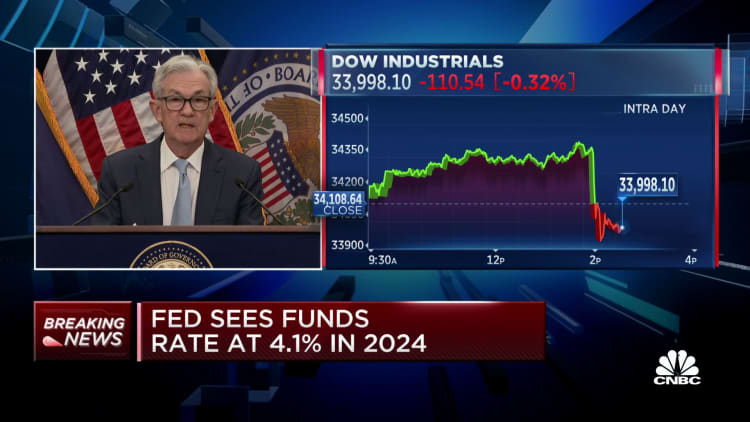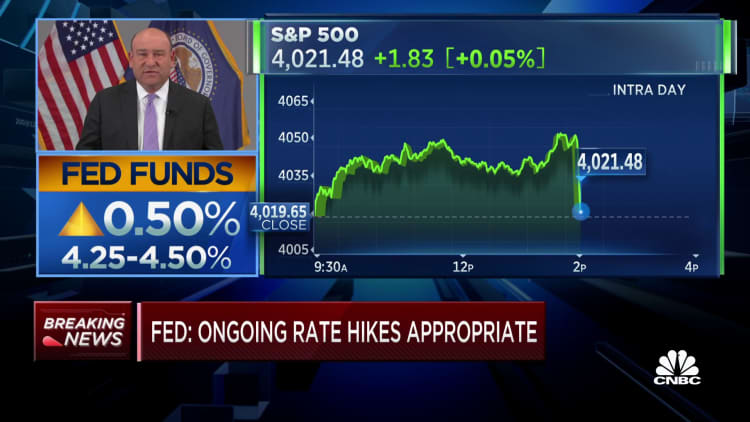Federal Reserve Hikes Interest Rates 0.5% to Highest Level in 15 Years
- The Federal Reserve continued its battle against inflation by raising its benchmark interest rate to the highest level in 15 years.
- The Federal Open Market Committee voted to boost the overnight borrowing rate half a percentage point, taking it to a targeted range between 4.25% and 4.5%.
- Along with the increase came an indication that officials expect to keep rates higher through next year, with no reductions until 2024.
The Federal Reserve on Wednesday raised its benchmark interest rate to the highest level in 15 years, indicating that the fight against inflation is not over despite some promising signs lately.
Keeping with expectations, the rate-setting Federal Open Market Committee voted to boost the overnight borrowing rate half a percentage point, taking it to a targeted range between 4.25% and 4.5%. The increase broke a string of four straight three-quarter point hikes, the most aggressive policy moves since the early 1980s.
Along with the increase came an indication that officials expect to keep rates higher through next year, with no reductions until 2024. The expected “terminal rate,” or point where officials expect to end the rate hikes, was put at 5.1%, according to the FOMC’s “dot plot” of individual members’ expectations.

Investors reacted negatively to the expectation that rates may stay higher for longer, and stocks gave up earlier gains. During a press conference, Chairman Jerome Powell said it was important to keep up the fight against inflation so that the expectation of higher prices does not become entrenched.
“Inflation data received to far for October and November show a welcome reduction in the monthly pace of price increases,” the chair said at his post-meeting news conference. “But it will take substantially more evidence to have confidence that inflation is on a sustained downward” path.
The new level marks the highest the fed funds rate has been since December 2007, just ahead of the global financial crisis and as the Fed was loosening policy aggressively to combat what would turn into the worst economic downturn since the Great Depression.
This time around, the Fed is raising rates into what is expected to be a moribund economy in 2023.
Members penciled in increases for the funds rate until it hits a median level of 5.1% next year, equivalent to a target range of 5%-5.25. At that point, officials are likely to pause to allow the impact of monetary policy tightening to make its way through the economy.
The consensus then pointed to a full percentage point worth of rate cuts in 2024, taking the funds rate to 4.1% by the end of that year. That is followed by another percentage point of cuts in 2025 to a rate of 3.1%, before the benchmark settles into a longer-run neutral level of 2.5%.
However, there was a fairly wide dispersion in the outlook for future years, indicating that members are uncertain about what is ahead for an economy dealing with the worst inflation it has seen since the early 1980s.
The newest dot plot featured multiple members seeing rates heading considerably higher than the median point for 2023 and 2024. For 2023, seven of the 19 committee members – voters and nonvoters included – saw rates rising above 5.25%. Similarly, there were seven members who saw rates higher than the median 4.1% in 2024.
The FOMC policy statement, approved unanimously, was virtually unchanged from November’s meeting. Some observers had expected the Fed to alter language that it sees “ongoing increases” ahead to something less committal, but that phrase remained in the statement.
Fed officials believe raising rates helps take money out the economy, reducing demand and ultimately pulling prices lower after inflation spiked to its highest level in more than 40 years.
The FOMC lowered its growth targets for 2023, putting expected GDP gains at just 0.5%, barely above what would be considered a recession. The GDP outlook for this year also was put at 0.5%. In the September projections, the committee expected 0.2% growth this year and 1.2% next.
The committee also raised its median anticipation of its favored core inflation measure to 4.8%, up 0.3 percentage points from the September outlook. Members slightly lowered their unemployment rate outlook for this year and bumped it a bit higher for the ensuing years.
The rate hike follows consecutive reports showing progress in the inflation fight.
The Labor Department reported Tuesday that the consumer price index rose just 0.1% in November, a smaller increase than expected as the 12-month rate dropped to 7.1%. Excluding food and energy, the core CPI rate was at 6%. Both measures were the lowest since December 2021. A level the Fed puts more weight on, the core personal consumption expenditures price index, fell to a 5% annual rate in October.
However, all of those readings remain well above the Fed’s 2% target. Officials have stressed the need to see consistent declines in inflation and have warned against relying too much on trends over just a few months.
Powell said the recent news was welcome but he still sees services inflation as too high.
“There’s an expectation really that the services inflation will not move down so quickly, so we’ll have to stay at it,” he said. “We may have to raise rates higher to get where we want to go.”
Central bankers still feel they have leeway to raise rates, as hiring remains strong and consumers, who drive about two-thirds of all U.S. economic activity, are continuing to spend.
Nonfarm payrolls grew by a faster than expected 263,000 in November, while the Atlanta Fed is tracking GDP growth of 3.2% for the fourth quarter. Retail sales grew 1.3% in October and were up 8.3% on an annual basis, indicating that consumers so far are weathering the inflation storm.
Inflation came about from a convergence of at least three factors: Outsized demand for goods during the pandemic that created severe supply chain issues, Russia’s invasion of Ukraine that coincided with a spike in energy prices, and trillions in monetary and fiscal stimulus that created a glut of dollars looking for a place to go.
After spending much of 2021 dismissing the price increases as “transitory,” the Fed started raising interest rates in March of this year, first tentatively and then more aggressively, with the previous four increases in 0.75 percentage point increments. Prior to this year, the Fed had not raised rates more than a quarter point at a time in 22 years.
The Fed also has been engaged in “quantitative tightening,” a process in which it is allowing proceeds from maturing bonds to roll off its balance sheet each month rather than reinvesting them.
A capped total of $95 billion is being allowed to run off each month, resulting in a $332 billion decline in the balance sheet since early June. The balance sheet now stands at $8.63 trillion.
" Conservative News Daily does not always share or support the views and opinions expressed here; they are just those of the writer."







Now loading...